FEBRUARY 1933
Scroll down to read
Five February 1933 posts

FEBRUARY 3, 1933
"Shattering US Customs Records"
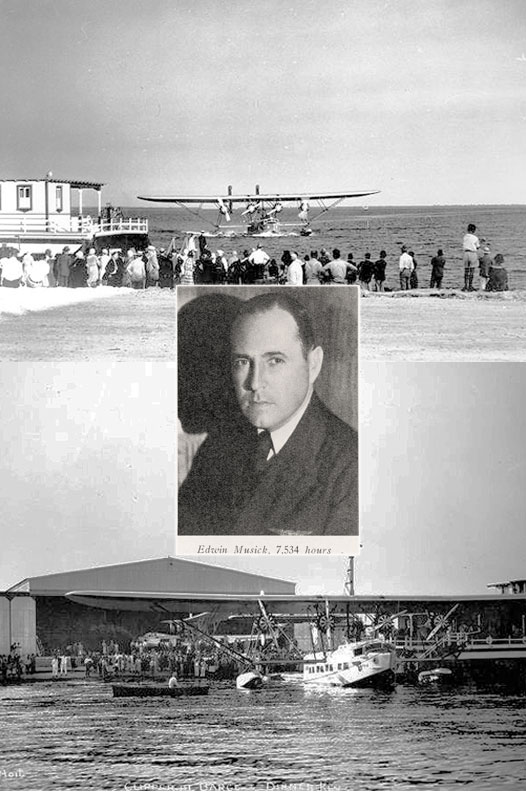 Photos of Sikorsky S-40s: “From the old floating barge which was anchored off Dinner Key in Biscayne Bay, originated many historic PAA flights throughout the Caribbean. From here the Sikorsky S-40s (first of the four engine seaplanes) operated during the days before the permanent Dinner Key land terminal building was built.” Photo IDs #RC15276 and #RC15294 at State Archives of Florida, Florida Memory, https://www.floridamemory.com
Photos of Sikorsky S-40s: “From the old floating barge which was anchored off Dinner Key in Biscayne Bay, originated many historic PAA flights throughout the Caribbean. From here the Sikorsky S-40s (first of the four engine seaplanes) operated during the days before the permanent Dinner Key land terminal building was built.” Photo IDs #RC15276 and #RC15294 at State Archives of Florida, Florida Memory, https://www.floridamemory.com
Photo of Capt. Ed Musick photo from "Pan American Air Ways," April 1931 (PAHF collection).
Pan Am’s Chief Pilot, Edwin Musick, left Kingston, Jamaica, at 8:00 a.m., Tuesday, February 7, 1933 for Miami in American Clipper (S-40 NC80V) ending his 800th round-trip since Pan American Airways started five-and-a-half years earlier. Ed had logged 4,200 flight hours spanning 421,000 miles transporting 9,000 passengers during which, as Kingston’s Daily Gleaner, reported, “There has been no trouble on any of the flights made by the Chief Pilot.”
500 of Musick’s flights ended in Miami.* According to "Pan American Air Ways" newsletter
“customs officials …think there ought to be a law: 500 times they have inspected Pilot Musick's papers, peeked into the same battered traveling bag at the same safety razor and toothbrush. They think that winning his entry into the United States half a thousand times ought to give him permanent possession, or …a badge or gold medal.”
At this point, Musick’s Pan Am service averaged 764 flight hours and 76,500 air miles (three circumnavigations of Earth) per year, carrying 11.25 passengers per flight, an impressive passenger load because Pan Am owned no 10+ seat aircraft before September 1930 and most flights carried more airmail, express packages, and employees than ticketed passengers in 1933.
* Musick’s actual Miami arrivals were higher: a mid-1920s “rum runner,” his trips to The Bahamas’ “rum fleet” avoided U.S. Customs; along Florida’s southern Atlantic coast police wished to inspect his cargo.
Sources:
•“Great Record of Pan American Flier,” The Daily Gleaner, 2/7/`33, p. 3.
•“Champion Comer-In” Pan American Air Ways, Vol. 4. No. 1, p. 3 https://digitalcollections.library.miami.edu/digital/collection/asm0341/id/40846/rec/1https://digitalcollections.library.miami.edu/digital/collection/asm0341/id/40846/rec/1

FEBRUARY 8, 1933
"Wine `Em, Dine `Em, Ticket `Em"
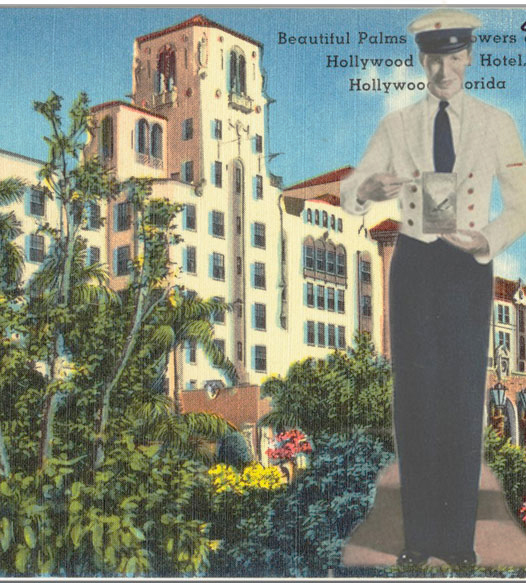 Photomontage:
Photomontage:
"'Rodney the Smiling Steward,' whose Mission in Life is to Give Away the 'New Idea [in Winter Travel] Booklet'" was a standing figure of a Pan Am steward displayed in travel agencies and ticket offices as a welcoming promotion. ("Pan American Air Ways," Vol. 4, No. 1).
Postcard: "Beautiful palms and flowers of the Hollywood Beach Hotel, Hollywood, Florida." Date:[ca. 1930–1945].
Postcards, Boston Public Library. The Tichnor Brothers Collection
https://ark.digitalcommonwealth.org/ark:/50959/t722hb640
Staff at the seven-year-old, seven-story, 500-room, Mediterranean-style Hollywood Beach Hotel, 101 North Ocean Dr., Hollywood, FL, parked, welcomed, and ushered five-hundred guests Tuesday evening, February 2, 1932 to a lavish party. Guests mingled waiting for the grand ballroom doors to open and the party to start.
At the appointed time, several Pan American Airways Stewards appeared, pushed back the ballroom doors singing, "Dinner is ready in the hangar." The guests entered a ballroom reflecting a set-designer’s vision of an airplane hanger replete with “Clipper Ships and travel posters” patrolled by waiters dressed as Pan Am Stewards.
The soirée kicked off a year-long marketing push featuring “ten travel parties … each …set supposedly in some country along the airways.”
The guest list was not disclosed; undoubtedly, many were Miami-Fort Lauderdale winter residents. Wealthy “snow birds” arrived in the late Fall and remained until the Northeast’s Spring-Summer social season, filling the Hollywood Beach Hotel and waterfront mansions. Pan Am hoped to wean this clientele from steamship lines onto airplanes as the fast and fashionable way to travel throughout the Caribbean, South America, and, hopefully, the Orient and Europe.
Source:
"Pan American Air Ways," Vol. 4., No 1., March 1933, p. 4.

FEBRUARY 14, 1933
"Fly With Me: Love, Pan American Style"
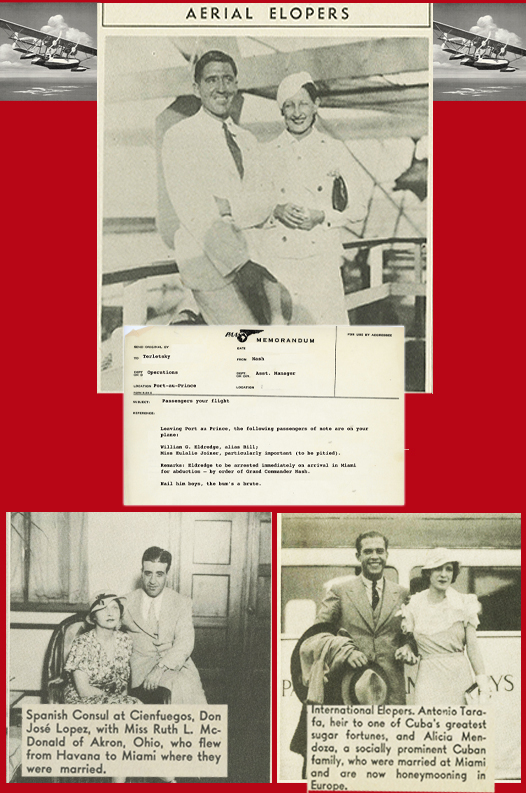 Photomontage: Top: Eldredge/Joiner Elopement. “Pan American Air Ways,” Vol. 4, No. 5, (Oct. 1933) p. 19. Middle: Mock-up of Memorandum from J.C. Nash to Leo Terletsky. Bottom left: Rives-Lopez/McDonald Marriage Bottom right: Tarafa/Mendoza Elopement. “Pan American Air Ways,” Vol. 4, No. 3, (June 1933) pp. 17 & 18.
Photomontage: Top: Eldredge/Joiner Elopement. “Pan American Air Ways,” Vol. 4, No. 5, (Oct. 1933) p. 19. Middle: Mock-up of Memorandum from J.C. Nash to Leo Terletsky. Bottom left: Rives-Lopez/McDonald Marriage Bottom right: Tarafa/Mendoza Elopement. “Pan American Air Ways,” Vol. 4, No. 3, (June 1933) pp. 17 & 18.
Passengers were seated when Port au Prince, Haiti’s, Relief Airport Manager, J.C. Nash, tapped the Consolidated Commodore cockpit window waving a Pan Am memo. Pilot Leo Terletsky opened the window, took the page and read:
"Leaving Port au Prince, the following passengers of note are on your plane: William G. Eldredge, alias Bill; Miss Eulalie Joiner, particularly important (to be pitied).
"Remarks: Eldredge to be arrested immediately on arrival in Miami for abduction — by order of Grand Commander Nash. Nail him boys, the bum's a brute."
"Pan American Air Ways" reported Port au Prince Airport Manager William G. Eldredge “Snatch(ed) his fiancée, Miss Eulalie Joiner, from friends and family who had gathered … to wish him a happy vacation.” Eulalie was a willing abductee as shown during U.S. Customs inspection in Miami where “Eldredge's baggage revealed a plentiful supply of feminine apparel.”
“Airborne elopements via Pan Am were becoming commonplace,” "Pan American Air Ways" added, because “Cuban couples with an eye on romance and matrimony find Miami an excellent goal.” One "a la Pan American" marriage involved “Jose Rives … Spain’s Consul at Cienfuegos, Cuba, and Ruth https://digitalcollections.library.miami.edu/digital/collection/asm0341/id/41160/rec/5Longmade McDonald of Akron, Ohio.” The couple “arrived by Clipper from Havana at five-fifteen, p.m., and … were married fifteen minutes later.”
Likewise, “Antonio Tarafa…and Miss Alice Mendoza … arrived from Havana on the American Clipper recently intent on marriage” had a civil ceremony, a religious service over a multi-day Miami Beach stay before boarding the overnight-train to New York, then on to Europe.
Sources:
PAA elopement stories: “Pan American Air Ways,” Vol. 4, No. 2, p.14; “Pan American Air Ways,” Vol. 4, No. 5, p. 18. https://digitalcollections.library.miami.edu/digital/collection/asm0341/id/41160/rec/5

FEBRUARY 22, 1933
"Oh, SOOO Cold, Copy!"
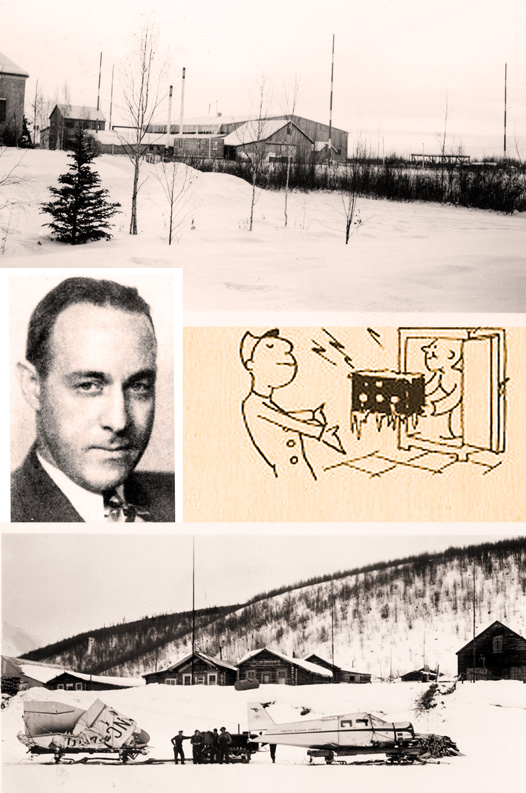 Photomontage (top to bottom): Pacific Alaska Airways facility with radio towers, PAHF/Clyde Smith Coll. Hugo Leuteritz, PAHF Collection. Radio Testing in Miami Cartoon, from PAAW, Vol 4. No. 1, p. 4. Pacific Alaska Airways retrieval of damaged aircraft, PAHF/Clyde Smith Coll.
Photomontage (top to bottom): Pacific Alaska Airways facility with radio towers, PAHF/Clyde Smith Coll. Hugo Leuteritz, PAHF Collection. Radio Testing in Miami Cartoon, from PAAW, Vol 4. No. 1, p. 4. Pacific Alaska Airways retrieval of damaged aircraft, PAHF/Clyde Smith Coll.
Hugo Leuteritz, Pan American’s Chief Communications Engineer, had created, refined, and adapted technology to increase flight safety and efficiency as the company entered new markets and new environments. Hugo’s specialty was radios, the reason Chief Engineer, Andre Priester had insisted that Juan Trippe poach Leuteritz from Radio Corporation of America (RCA).
Since 1927, Leuteritz had patented systems to track aircraft in flight, refined radio-beacon navigation, constructed 61 radio stations throughout Central and South America, minimized equatorial-zone radio interference, and engineered the world’s lightest airborne radio sets. With 1932’s acquisition of three Alaska airlines, Hugo faced a new question: would Pan Am’s radios work in extended sub-zero temperatures?
According to "Pan American Air Ways reports," working 4,000 miles from the new Anchorage base, Leuteritz’s Miami team responded practically. They placed “(radios) into a refrigerator at the Maintenance Base,” where “the sets were urged to do their act amid wintry blasts while engineers stood outside and peered in anxiously from time to time to see how they behaved. Reception was cold but perfect.”
While his department supplied Alaska with reliable cold-hardened radio systems, Leuteritz knew this research applied throughout the PAA system. One radio system would serve atop Argentina’s Mount La Cumbre at 12,500 feet altitude in weather challenging anything Alaska dished up.
Source: "Pan American Air Ways," Vol. 4, No. 1, p. 4, University of Miami Special Collections, Pan American World Airways, Inc. records. htthttps://digitalcollections.library.miami.edu/digital/collection/asm0341/id/40847/rec/1

FEBRUARY 23, 1933
"Weather Talk"
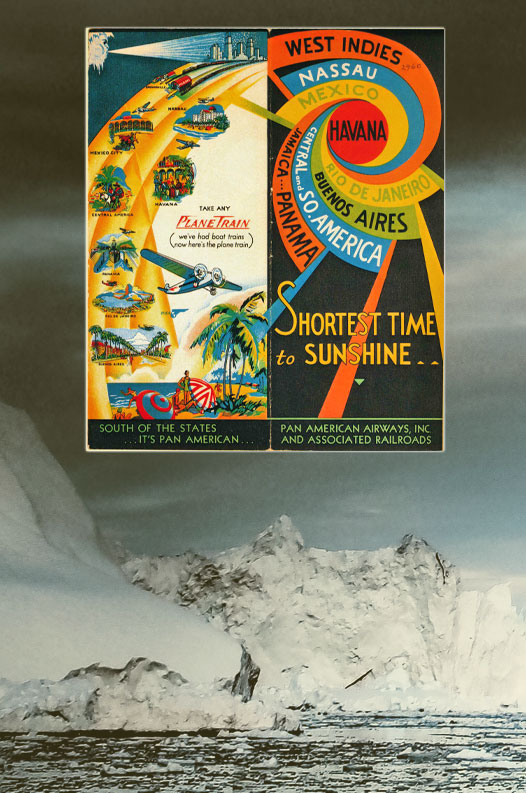
Photomontage: (1) Shortest Time to Sunshine, Pan Am Plane-Train brochure c. 1930, PAHF/Don Thomas collection.
(2) Ilulissat, Greenland by Jennifer Latuperisa-Andresen on Unsplash.
Published on October 27, 2017 https://unsplash.com/photos/U1y2ye6nPks
"'Next door to Winter are lands of Sunshine. Brief hours will take you there,' Pan American tells its prospective winter travelers. And this statement is greeted with varied emotions by those connected with the great international air transport line. Down on the equator, the sun of midday is a subject for feeling content if not always for unqualified approbation.If February 23 found you gazing at a thermometer which threatened to boil over, give a thought to the members of the Pan-American-University of Michigan West Greenland expedition. On that date the members of this group of hardy explorers crawled from their shack, faced due south, and waited. After an appropriate interval, over the southern horizon appeared the sun — only for a brief moment, and then it was gone. They looked at one another in congratulation. It was their first glimpse of sunlight in two months!"
Quotation from "Pan American Air Ways," Vol. 4, No. 1, p. 4.https://digitalcollections.library.miami.edu/digital/collection/asm0341/id/40847/rec/1

